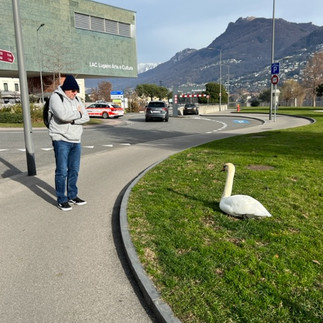Lugano Switzerland – Lugano Svizzera
- Maria Scuor
- Jan 23, 2023
- 9 min read
Updated: Feb 8, 2023
L'italiano segue ogni sezione

Lugano is a city and municipality in the Ticino canton (district) in Switzerland. It is the largest city and Italian speaking in Ticino. It has a population of about 65,000 people.
It is situated on Lake Lugano at its widest point and together with the town of Paradiso they take up the whole bay. They are surrounded by the western part of the Alps and both the eastern and western parts of the municipality share an international boarder with Italy.
The lake shores have been inhabited since the Stone Age and verified with Etruscan (language) monuments that date back to 5th to 2nd century BC. In the first century BC, Lugano was settled by Romans. The first written mention of settlement in Lugano is when king Luitprand ceded various assets of Lugano to the Church St. Carpophorus in Como in 724. The act of 984 indicates Lugano as a market town.
Lugano was the object of continued dispute between the Dukes of Como and Milan until it became a Swiss dominion in 1513. The von Beroldingen, a noble family from Uri served as chancellors of the Vogt residing in Lugano between 1576 and 1798. Karl Konrad von Beroldingen received the title of Baron from Emperor Leopold I in 1691 and commissioned the Palazzo Beroldingen on the property of what today is known Ciani Park.
Napoleon conquered the Old Swiss Confederation in 1798 and Lugano became the capital of the Canton of Lugano of Helvetica Republic in order to centralise the power in Switzerland. In 1803 after much unrest Lugano declared independence from Helvetica and the Municipality was formed.
With the Gotthard railway line connecting Europe, the station built in Lugano in 1877, transformed the town into one of the main links between Northern Italy and central and northern Europe. From the mid-19th century to 1970 the city recorded consistent population growth due to foreign nationals settling in Lugano.
What’s interesting is between 1960s and 70s, an abundant flow of capital from Italy caused a period of exponential growth in banking activities which led it to become the third financial centre of Switzerland. Today there are over 100 banks in Lugano, with finance, trade and tourism as the mainstays of the economy.
With Lugano being one of the warmest cities in Switzerland the lake area is a very popular destination. The lake is 18.8 square miles (48.7 km) in size, 63% of it in Switzerland and 37% in Italy. The maximum depth is 915 ft (279 meters). During the summer there are many boat tours, with the most popular excursion is going to the lakeside village of Gandria.
There are several museums, parks and buildings as well as a prestigious shopping district to see. During our day we got to see Gandria, Caini Park and St. Lawrence Cathedral which I will provide a section on each below.
Lugano Svizzera
Lugano è un comune svizzero del Canton Ticino. È la città più grande e di lingua italiana in Ticino. Ha una popolazione di circa 65.000 persone.
Si trova sul Lago di Lugano nel suo punto più largo e insieme alla città di Paradiso occupano l'intera baia. Sono circondati dalla parte occidentale delle Alpi e sia la parte orientale che quella occidentale del comune condividono un confine internazionale con l'Italia.
Le rive del lago sono state abitate fin dall'età della pietra e verificate con monumenti etruschi (lingua) che risalgono al 5 ° al 2° secolo aC. Nel I secolo a.C., Lugano fu colonizzata dai Romani. La prima menzione scritta di insediamenti a Lugano è quando il re Luitprando cedette vari beni di Lugano alla chiesa di San Carpoforo a Como nel 724. L'atto del 984 indica Lugano come città mercato.
Lugano fu oggetto di continue dispute tra i duchi di Como e Milano fino a quando divenne dominio svizzero nel 1513. I von Beroldingen, una famiglia nobile di Uri, furono cancellieri dei Vogt residenti a Lugano tra il 1576 e il 1798. Karl Konrad von Beroldingen ha ricevuto il titolo di barone dall'imperatore Leopoldo I nel 1691 e commissionò il Palazzo Beroldingen sulla proprietà di quello che oggi è noto Ciani Park.
Napoleone conquistò la Vecchia Confederazione Svizzera nel 1798 e Lugano divenne la capitale del Canton Lugano della Repubblica Elvetica per centralizzare il potere in Svizzera. Nel 1803, dopo molti disordini, Lugano dichiarò l'indipendenza dall'Helvetica e fu costituito il Comune.
Con la linea ferroviaria del San Gottardo che collegava l'Europa, la stazione costruita a Lugano nel 1877, trasformò la città in uno dei principali collegamenti tra il Nord Italia e l'Europa centrale e settentrionale. Dalla metà del 19° secolo al 1970 la città ha registrato una crescita demografica costante a causa dei cittadini stranieri che si stabilivano a Lugano.
Ciò che è interessante è che tra il 1960 e gli anni '70, un abbondante flusso di capitali dall'Italia ha causato un periodo di crescita esponenziale delle attività bancarie che lo ha portato a diventare il terzo centro finanziario della Svizzera. Oggi ci sono oltre 100 banche a Lugano, con la finanza, il commercio e il turismo come pilastri dell'economia.
Con Lugano che è una delle città più calde della Svizzera, la zona del lago è una destinazione molto popolare. Il lago ha una superficie di 48,7 km, il 63% delle quali in Svizzera e il 37% in Italia. La profondità massima è di 279 metri. Durante l'estate ci sono molti tour in barca, con l'escursione più popolare è andare al villaggio lacustre di Gandria.
Ci sono diversi musei, parchi ed edifici, e un prestigioso quartiere dello shopping da vedere. Durante la nostra giornata abbiamo avuto modo di vedere Gandria, Parco Caini e la Cattedrale di San Lorenzo che fornirò una sezione su ciascuno di seguito.
Here is a video and photos of the sights of Lugano – Ecco un video e le foto delle attrazioni di Lugano

Gandria Switzerland – Gandria Svizzera
Gandria is a district in the municipality of Lugano and has 275 inhabitants and it’s outskirts borders with the Italian town of Albogasio in Como. Until 2004, Gandria was and independent municipality until it joined Lugano.
Gandria includes the rural slopes surrounding the village up to the Swiss/Italian border. It also includes the slopes opposite side of lake around the small settlement of Cantina di Gandria, that are only accessible by boat or foot. The center of the village of Gandria, which is also only accessible by foot or boat, attracts many tourists. You can also access it by hiking the Olive Path which passes plantations of olive trees and amazing views of Lake Lugano.
The first inhabitants were the Celts around 800 BC and a large stone carved with Celtic signs can be found withing hiking distance. Gandria sits at the base of Mount Brè which means “mountain” in Celtic. First mention of the village is mentioned by the bishop of Como in 1237, which at the time the town was situated half way up Mount Brè. It was the 14th century when the settlement was established along the present-day lake site.
Gandria is known for three things; olive oil, silk and smuggling. In 1709, the hard winter killed most of the olive trees which Gandria and in recent years, olive trees have been replanted. In 1856 the silk production industry began using the mulberry trees to feed the silkworms and because Gandria is close to the border, which was difficult to control, it became infamous for smuggling. Cigarettes, meat and alcohol were especially profitable due to high Swiss customs duties. The Swiss Customs Museum in Gandria, can be visited from April to October every year.
Gandria Svizzera
Gandria è una frazione del comune di Lugano e conta 275 abitanti e confina con la città italiana di Albogasio a Como. Fino al 2004, Gandria è stato un comune autonomo fino a quando è entrato a Lugano.
Gandria comprende i pendii rurali che circondano il villaggio fino al confine svizzero/italiano. Comprende anche le pendici sul lato opposto del lago intorno al piccolo insediamento di Cantina di Gandria, che sono accessibili solo in barca o a piedi. Il centro del villaggio di Gandria, che è anche accessibile solo a piedi o in barca, attira molti turisti. È inoltre possibile accedervi facendo escursioni lungo il sentiero degli ulivi che attraversa piantagioni di ulivi e una vista mozzafiato sul Lago di Lugano.
I primi abitanti furono i Celti intorno all'800 a.C. e una grande pietra scolpita con segni celtici si trova a breve distanza a piedi. Gandria si trova alla base del Monte Brè che significa "montagna" in celtico. La prima menzione del borgo è menzionata dal vescovo di Como nel 1237, che all'epoca la città era situata a metà strada sul Monte Brè. Era il 14° secolo quando l'insediamento fu stabilito lungo l'attuale sito del lago.
Gandria è conosciuta per tre cose; olio d'oliva, seta e contrabbando. Nel 1709, il rigido inverno uccise la maggior parte degli ulivi che Gandria e negli ultimi anni, gli ulivi sono stati ripiantati. Nel 1856 l'industria della seta iniziò a utilizzare i gelsi per nutrire i bachi da seta e poiché Gandria è vicina al confine, che era difficile da controllare, divenne tristemente famosa per il contrabbando. Sigarette, carne e alcol erano particolarmente redditizi a causa degli elevati dazi doganali svizzeri. Il Museo delle dogane svizzere di Gandria, può essere visitato da aprile a ottobre di ogni anno.
Ciani Park – Parco Ciani
Ciani Park is the largest park in Lugano and considered one of the most beautiful parks in Switzerland. It extends over 63,000 square meters and is rich of subtropical plants such as palms, exotic shrubs, roses, azaleas, magnolias and camellias. Positioned on the lakes shores of Lake Lugano it attracts many tourists and locals. There are beautiful walk ways, imposing trees, a large play park, statues, fountains and flowerbeds to explore.
Giacomo and Filippo Ciani, members of the Blenio family built the historic villa on the site. In 1912 the Municipality of Lugano took it over and since then the villa is a Historical Museum and Civic Museum of Fine Arts.
Parco Ciani
Il Parco Ciani è il più grande parco di Lugano ed è considerato uno dei parchi più belli della Svizzera. Si estende su 63.000 metri quadrati ed è ricca di piante subtropicali come palme, arbusti esotici, rose, azalee, magnolie e camelie. Posizionato sulle rive dei laghi del Lago di Lugano attira molti turisti e locali. Ci sono bellissimi sentieri a piedi, alberi imponenti, un grande parco giochi, statue, fontane e aiuole da esplorare.
Giacomo e Filippo Ciani, membri della famiglia Blenio costruirono la villa storica sul sito. Nel 1912 il Comune di Lugano la rilevò e da allora la villa è Museo Storico e Museo Civico di Belle Arti.
Here are photos of Ciani Park – Ecco le foto del Parco Ciani
St. Lawrence Cathedral - Cattedrale di San Lorenzo
St. Lawrence Cathedral is a Roman Catholic cathedral dedicated to St. Lawrence of Rome. The church was built on the site in 818 and in 1078 it was made a collegiate church (self-governing maintained by canons) and became a cathedral in 1888. The original building was in Romanesque architecture (medieval with semi-circular arches) and in the 15th century the church was expanded and the entrance moved to where it is today.
In 1971, by virtue of Pope Paul VI, the cathedral became an independent diocese and Giuseppe Martinoli became the first bishop of Lugano. The latest bishop, Valerio Lazzeri resigned his position in October 2022 and currently there is no bishop holding the holy seat in Lugano.
The main façade of the cathedral was inspired by the Certosa di Pavia, a rose window with cherub is in the main portal, there are five medallions in the central portal, and busts of Kings Solomon and David. Between 1905 – 1910 the decadent Baroque chapels were replaced with beautiful frescoes by artist Ernesto Rusca.
The façade is made of white Italian Carrara marble and makes the exterior just as glorious as its interiors. The church perpetually rests in the shadow of its looming bell tower, topped by a gleaming teal cupola. The best however is that the cathedral has incredible views of the town below and the imposing mountains that surround it.
Cattedrale di San Lorenzo
La cattedrale di San Lorenzo è una cattedrale cattolica dedicata a San Lorenzo di Roma. La chiesa fu costruita sul sito nell'818 e nel 1078 divenne una collegiata (autogoverno mantenuto dai canonici) e divenne una cattedrale nel 1888. L'edificio originale era in architettura romanica (medievale con archi semicircolari) e nel 15° secolo la chiesa fu ampliata e l'ingresso spostato dove è oggi.
Nel 1971, in virtù di papa Paolo VI, la cattedrale divenne diocesi autonoma e Giuseppe Martinoli divenne il primo vescovo di Lugano. L'ultimo vescovo, Valerio Lazzeri, si è dimesso dall'incarico nell'ottobre 2022 e attualmente non c'è nessun vescovo che detiene la santa sede a Lugano.
La facciata principale della cattedrale è stata ispirata dalla Certosa di Pavia, un rosone con cherubini è nel portale principale, ci sono cinque medaglioni nel portale centrale e busti dei re Salomone e Davide. Tra il 1905 e il 1910 le decadenti cappelle barocche furono sostituite con bellissimi affreschi dell'artista Ernesto Rusca.
La facciata è realizzata in marmo bianco italiano di Carrara e rende l'esterno glorioso come i suoi interni. La chiesa riposa perennemente all'ombra del suo incombente campanile, sormontato da una scintillante cupola verde acqua. La cosa migliore, tuttavia, è che la cattedrale ha una vista incredibile sulla città sottostante e sulle imponenti montagne che la circondano.



































































































































































Commentaires